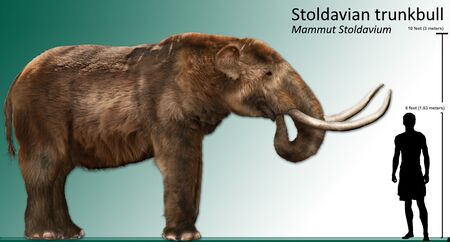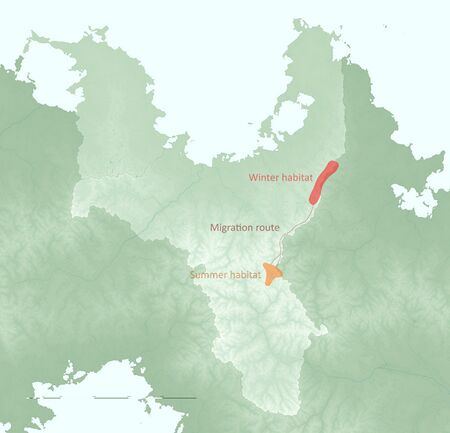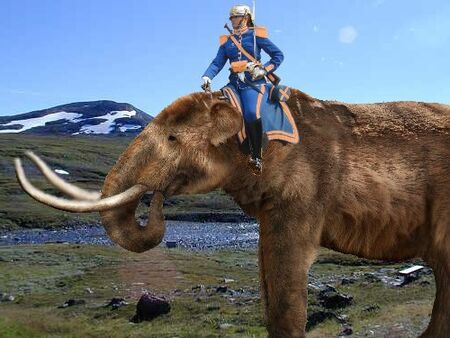Trunkbull

Trunkbulls are large tusked mammal species of the genus Mammut and therefore closely related to the elephant. The only surviving subspecies, the Stoldavian Trunkbull (Mammut Stoldavium) are living in the wild in Vittmark and some surrounding territories. Trunkbull species used to inhabit large parts of Anaria, Tarna and Davai, but are extinct there now. There are an estimated amount of a few hundred wild trunkbulls gathered in twelve herds roaming freely through Vittmark, with an equal amount of solitary males, making the total wild population about 600 - 800 animals. The amount of domesticated animals is about 300.
Description
While trunkbulls have a size and appearance similar to elephants and mammoths, they are not particularly closely related. Their teeth differ dramatically from those of members of the elephant family; they have blunt, conical, nipple-like projections on the crowns of their molars, which are more suited to chewing leaves than the high-crowned teeth mammoths used for grazing. Their skulls are larger and flatter than those of mammoths, while their skeleton is stockier and more robust. Trunkbulls are about 2 to 2.5 meters high (8 to 11 ft) with the bulls being about 1 or 2 feet larger than the cows. Their tusks can be unusually long in comparison to their body size, there is a wide variation in size.
Trunks
The proboscis, or trunk, is a fusion of the nose and upper lip, elongated and specialised to become the animal's most important and versatile appendage. The bull's trunk is sensitive enough to pick up a single blade of grass, yet strong enough to rip the branches off a tree. Most herbivores possess teeth adapted for cutting and tearing off plant materials, but the trunkbull always use their trunks to tear up their food and then place it in their mouths. The trunk is also used for drinking, sucking water up into the trunk and then blowing it into their mouths. Trunkbulls also rely on their trunks for their highly developed sense of smell. By raising the trunk up in the air and swiveling it from side to side, it can determine the location of friends, enemies, and food sources.
Tusks
The tusks are its second upper incisors, which grow continuously. Tusks are used to dig for water, to debark trees to eat the bark and to uproot bushes and heather for consumption. Both male and female trunkbulls have large tusks that can reach over 5 m (18 ft) in length and weigh over 120 kg, although usually the tusks are only half that size.
Skin and fur
A trunkbull's skin is extremely tough around most parts of its body and measures about 2 centimeters (0.8 in) thick. However, the skin around the mouth and inside of the ear is considerably thinner. Trunkbulls have a thick, furry coat of shaggy hair. Different herds have different colors of fur, depending on their habitat and migration routes, ranging from grayish brown to orangy. The combination of the thick skin and furry coat provide good isolation for this large animal, which is living in an area with a relatively cold climate. Trunkbulls have very little skin surface in relation to their size and volume.
Ears
In comparison with its distant cousin the elephant, the trunkbull has very small ears. The backside of the ear has no fur, and is used for cooling during the short summer season. Trunkbulls will flap their ears to get rid of excess heat, behaviour one only sees during the midst of summer. But usually, making the skin and fur wet with a bath in some lake or pool is a more effective way to get rid of excessive heat.
Distribution

The last remaining trunkbulls in the wild are gathered in one particular mountain plateau called Gäddedevida on the border of Sörmark and Ådalen states during the summer season. The area is about 2500 km2 large. Due to the severe winters at this high altitude, the trunkbulls migrate across the mountain flanks to the north, where they can browse on coniferous trees, erica and heather in the forested highlands of Liden and Östra Haga. Their winter habitat might reach further north when wintes are longer, feeding at lower altitudes in the border region.
Individual animals might stray up to 200 km outside the core habitats. These often need to be captured and taken to an area that suits their lifestyle. After tagging them they are released in the wild. If tagged animals get lost more often, it is a sign that the animal can't survive in the wild.
This migration across 250-400 km is needed for the animal to get different types of food supplies during a year. It is however unknown if the migration is natural behaviour, or that it was introduced by the Bengtist caretakers. They traveled through southern Liden and parts of Hagen with domesticated groups of animals to provide services in building and landscaping.
Behavior
Trunkbulls are browsers, feeding mainly on leaves, from trees as well as bushes. Their diet varies with the season, during the summer half year it's mainly birch, willow, blueberry and lingonberry leaves. The winter season offers conifers (cypress), podocarpus alpinus, heather, erica (cross-leaved heath) and bilberry.
Due to their diet, they have to migrate with the seasons. Their natural habitat is limited to a region between the Blue Mountains in southcentral Vittmark to the hill regions of Hagen. They prefer taiga landscapes and not too dense coniferous forests. Even though trunkbulls can run up to 40 km/h, they only migrate about 15 - 25 km a day. It is unknown if the migration is natural behaviour. Domesticated animals hardly reproduce, so the Bengtist caretakers experimented with letting parts of their herds roam freely to produce offspring. It is possible that this wild offspring simply kept following the same migration patterns as their ancestors.
Contrary to the elephant, which lives in matriarchal groups and solitary males, the trunkbull's social group has one dominant male. This does not have to be the herd's leader, in most groups (about 60-70%) this still is a female trunkbull. Other males live solitary or in duos, but couples of an (often young) male and female have been observed as well. This is generally believed to be a variation in the social structure of the trunkbulls in this particular population, which has led to their survival up to today in a small region of Stoldavia.
Domesticated trunkbulls have been found to recognise themselves in a mirror, putting them in an exclusive club of self-awareness whose other members are great apes (including humans) and bottlenose dolphins. Individuals and small groups living in capticity, like the Trunkbull Wildlife Sanctuary in Gäddedevida, also seem to respond to human body language like pointing. They also respond differently to human languages that are not Wortsproke but recently elephants have shown a similar behaviour regarding human intonation and languages as well.
Body language is an important part of the communication between individuals. Unlike the elephant, trunkbulls hardly use trumpeting in their communication, but stick to grunts, rors and barking like sounds.
Trunkbulls show signs of empathy and even show symptoms of grief and mourning. They caress the bones of the dead with their trunks and will stand near the body of the deceased for hours.
Trunkbulls in culture and religion

The animals play a large role in Orkanan, which has its roots in previous belief systems. During the Orkanan Realm and the Greater Stoldavic Empire, trunkbulls played an important part in the military success of the empires. This has strengthened the idea that trunkbulls are a tool provided by Vind to convert people in large areas. The almost holy status is also used for nationalist purposes: the trunkbull is seen as a symbol of Stoldavic supremacy and the presence of these large animals is considered eminent for the survival of Stoldavic values and interests.
Trunkbulls can be domesticated, but hardly breed in captivity. Tamed animals will have to be taken from nature, which during history almost has led to its extinction. During the latter days of the Stoldavic Empire, when trunkbulls became scarce, one group of (non-interventionist) Orkanans under the leadership of Bengt Algotson chose to release a group of animals and follow them to study their natural behavior. Trunkbulls were thought to have become extinct, and even though several sightings of individuals were still reported, the herd from Bengt was not seen for 30 years. It turned out that the group of Bengtists had led the animals to their natural habitat and gradually had learned about their migration patterns. The herd became a magnet for individual bulls, which led to a viable population. After 30 years, Algotson reported in with his herd of trunkbulls at the castle of Kulla during a severe winter. It was only then when the legend of Bengt could be confirmed by a documented report. Since the military reason for Bengt's mission had dissipated, his followers kept on following the trunkbulls on their ever more elaborate migration paths. Over the next two generations, the original group had been divided into four traveling herds by natural causes. Each group got its own travelling Order of protectors and observers. Today, twelve travelling orders are registered.
Some domesticated trunkbulls are used for ceremonial purposes, like military parades and official guards. The military use of trunkbulls is prohibited these days.